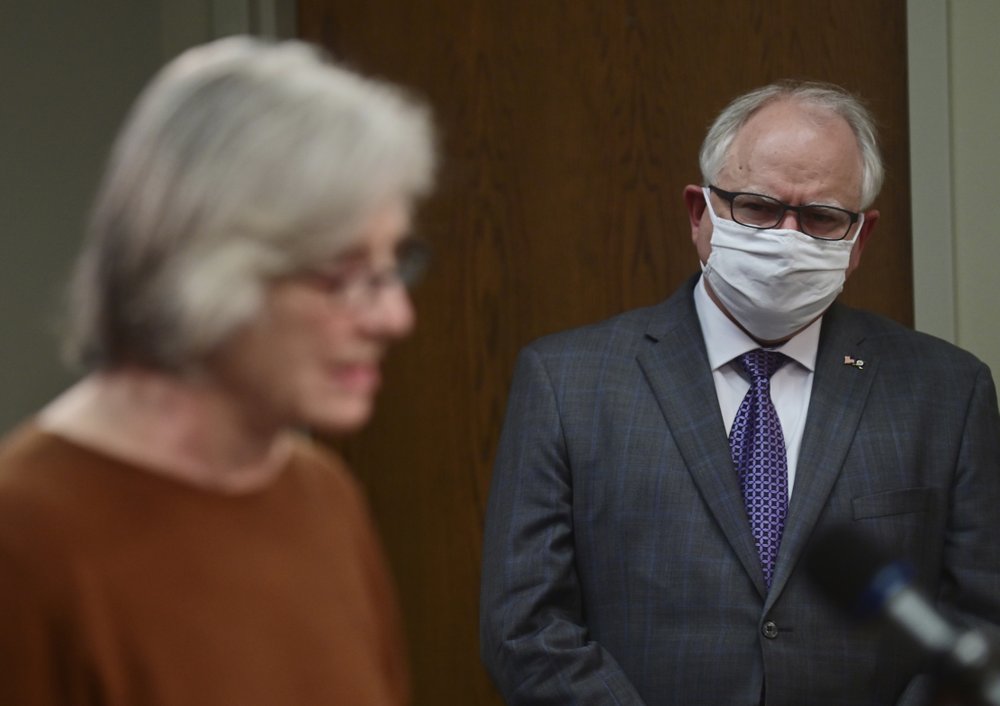Minnesota
UPDATE: Four-week shutdown in Minnesota as COVID-19 spread soars

MINNEAPOLIS (AP) — Minnesota Gov. Tim Walz on Wednesday imposed four weeks worth of new COVID-19 restrictions as the spread spiked to an all-time high, shutting down bars, restaurants and fitness centers, while pausing social gatherings and organized amateur sports.
The announcement came on a day when Minnesota recorded a record 67 new COVID-19-related deaths, pushing the state’s toll to 3,010. The Minnesota Department of Health also reported 5,102 confirmed new cases, rising the state’s total to 242,053. State officials said they expected to top 300,000 cases sometime next week.
The governor said in a televised address that it made a difference when Minnesotans endured a lockdown last spring, and that they need to take a pause again to protect a health care system that is at a breaking point. While the state has built up its bed capacity and supplies of personal protective equipment since the lockdown, he said, doctors, nurses and other care staff are now increasingly falling ill because of community spread.
“I understand it’s not easy and it’s not fair,” Walz said. “But it’s a sacrifice that we need to make. If we don’t do that, and we continue to spread, we will with absolute certainty put our hospitals at risk, and those that need the care, as well as the care providers.”
Beginning Friday at 11:59 p.m. through Friday, Dec. 18, in-person social gatherings with individuals outside one’s own household, including wedding receptions, are prohibited. Bars and restaurants are limited to takeout and delivery service only. Fitness clubs, entertainment and event venues must close. Adult and youth sports are paused, though college and pro sports are exempt.
But retail businesses, child care centers, salons, and places of worship can stay open with proper precautions under current restrictions. Schools will continue to operate with a mix of in-person, distance and hybrid learning.
The governor’s office issued statements from Minnesota health care leaders who said the tighter restrictions are necessary as hospitals fill up while staffing them becomes harder.
“The current explosive level of community transmission of COVID-19 in Minnesota means that our health care heroes – including nurses, physicians, therapists, pharmacists, support services, housekeeping, technicians, advanced practice providers and many more – are contracting COVID-19 as they go about their daily lives,” Dr. Rahul Korrane, president and CEO of the Minnesota Medical Association.”
Walz said at a news conference after his speech that the data on whether the new restrictions are making a difference will drive his decision on whether to dial them back at the end of the four weeks.
Health department figures show that over 4,100 coronavirus cases have been linked to outbreaks at restaurants and bars since June 10, while at least 950 cases have been linked with weddings, 780 with sports and nearly 750 with gyms. Health Commissioner Jan Malcolm said those statistics are an undercount because they don’t reflect spread beyond the primary cases. Those cases have taken a sharp upturn in recent weeks, she said.
Employment and Economic Development Commissioner Steve Grove said the state is ready for a surge in new applications for unemployment insurance and will be able to borrow the money from the federal government. The governor announced $10 million in small business relief grants last week, and on Wednesday asked the state’s congressional delegation for help in securing more federal aid.
“Let’s be very clear: this is the federal government’s major responsibility. They have failed at it,” Walz told reporters. “And I don’t care whether it’s the current administration or the incoming new administration, Congress needs to figure out how to make sure that that aid gets there.”
The Minnesota Business Partnership, which represents chief executives from more than 100 of Minnesota’s largest employers, broadly backed the measures while recognizing the negative impacts, particularly on small businesses. The hospitality industry was more critical.
“Today’s action will push many small restaurants, food service and other hospitality businesses over the cliff,” Liz Rammer, president and CEO of the trade group Hospitality Minnesota, said in a statement. She called for “immediate financial assistance from the state or these businesses will not be here in four weeks.”
Tony Chesak, executive director of the Minnesota Licensed Beverage Association, which represents bars and restaurants that serve liquor, predicted a “devastating” further permanent loss of places to eat and drink.
“The state and federal government both need to take steps to aid employees and the hospitality industry with relaxed regulations, direct financial support, unemployment assistance, and loans to get through this dark winter,” Chesak said in a statement.
Bahram Akradi, CEO of the Chanhassen-based Life Time chain of fitness clubs, said in an interview that he will have to furlough 4,000 workers in Minnesota who were brought back when the clubs reopened earlier this year, while 120,000 members will lose a “safe haven” for maintaining their health. He said his clubs have put extensive safeguards in place, and that it’s unfair gyms have been singled out while retailers have not.
Let Them Play MN, a group of parents, coaches and kids who want youth sports to be allowed during the pandemic, urged Walz to reconsider, calling youth sports “an important bright spot” in a difficult year. Affected sports will include prep football and volleyball.
“Coaches and schools have adopted protocols that help prevent the spread of COVID more than the things teens will do without sports,” Rocori High School head football coach James Herberg said in the group’s statement. “Cancelling sports may sound helpful on paper, but with no protocols or supervision, the spread will be worse.”

